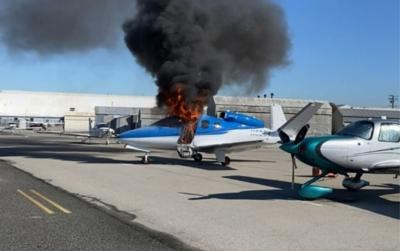Smoke Had Become Dense, And The Airplane Cabin Became Engulfed In Flames
Location: Santa Monica, California Accident Number: WPR20FA051
Date & Time: December 27, 2019, 11:55 Local Registration: N52CV
Aircraft: Cirrus SF50 Aircraft Damage: Substantial
Defining Event: Fire/smoke (non-impact) Injuries: 1 None
Flight Conducted Under: Part 91: General aviation - Personal Analysis

After starting the airplane’s engine for a planned flight, the pilot began to smell smoke, which became stronger as he continued with flight preparations. The pilot decided to terminate flight preparations and have a mechanic examine the airplane. After shutting down the engine, the pilot saw smoke rising from the armrest area of the right center passenger seat. By the time the mechanic arrived, the smoke had become dense, and the airplane cabin became engulfed in flames a few minutes later.
Postaccident examinations revealed that the source of the fire was likely an audio interface card, which was part of a system that enabled occupants to connect their non-aviation headsets to the airplane’s intercom and entertainment system. The card was installed in the side panel of the airplane in the armrest area where smoke was first observed. Evaluation of the card revealed that its design allowed an excessive flow of current to pass through a current-limiting resistor in its power-protection circuit when its input filter capacitors or reference diode failed in a short-circuit condition. Under this scenario, the flow of current resulted in the resistor having to dissipate more power than it was rated for, resulting in a buildup of heat.
The design called for the use of either a wire-wound or thick-film current-limiting resistor. Testing revealed that, under the short-circuit condition, designs with both types of resistors would result in heat sufficient to create thermal damage. The thick-film design would typically fail in an open circuit a short time later and return to a normal temperature; however, the wirewound resistor would continue to produce heat and eventually an open flame.

Compounding the electrical design flaw was the physical installation of the cards, which were encased in a heat-shrink sleeve and then wrapped with nylon cable ties to standoffs on the inside of the panel walls. The use of a heat-shrink sleeve to cover the boards meant that most of the components were in direct contact with the sleeve when shrunk. The contact was even more pronounced against the input filter capacitors because they were mounted near the board’s edge. Additionally, because the units were held to the airframe with nylon cable ties that wrapped around the boards, the components were subject to external forces, from contact with the ties, during installation and throughout their lifetime.
The manufacturer of the input filter capacitors specifically stated that stress after installation could result in a crack that might cause a short circuit. Because four input filter capacitors were used, all of which were installed in parallel, the chance of failure and short circuit increased by a factor of four. The capacitor manufacturer further stated that, if the circuit being used caused an electrical shock, smoke, or fire when a capacitor is shorted, a fail-safe device, such as a fuse, would prevent secondary accidents.
The audio cards were powered via a 5-ampere circuit breaker used by the airplane’s audio panel. Although this power rating was appropriate for the audio panel and all audio cards, the current drawn by an individual audio card short circuit was not sufficient to cause the circuit breaker to trip. The audio cards did not incorporate any internal or external secondary fuse. Postaccident flammability testing indicated that the cards would fail in an open circuit and self-extinguish after igniting except for one card, which was equipped with a wire-wound resistor and continued to produce an intermittent flame as long as power was supplied. As a result, the flame continued to burn and created hot flaming drips.
The accident airplane was equipped with audio cards that used a wire-wound resistor. It is likely that, when the pilot engaged the airplanes electrical power via the master switch, one of the cards mounted in the right side panel failed in short-circuit, creating the flame that eventually consumed the airplane cabin.
A Federal Aviation Administration airworthiness directive resulted in the removal of all audio interface cards from all equipped Cirrus airplanes. The manufacturer then redesigned the audio cards and increased the resistance and power rating for the current-limiting resistor such that, under a short-circuit condition, the resistor’s power rating could not be exceeded. The manufacturer also replaced the input filter capacitors with a more robust, single capacitor and encased the unit in a plastic box filled with potting compound.
Probable Cause and Findings
The National Transportation Safety Board determines the probable cause(s) of this accident to be: The improper design of the audio interface system, which caused an electrical short circuit that led to a ground fire.
 ANN's Daily Aero-Term (04.26.24): DETRESFA (Distress Phrase)
ANN's Daily Aero-Term (04.26.24): DETRESFA (Distress Phrase) Aero-News: Quote of the Day (04.26.24)
Aero-News: Quote of the Day (04.26.24) ANN's Daily Aero-Term (04.27.24): Direct
ANN's Daily Aero-Term (04.27.24): Direct ANN's Daily Aero-Linx (04.27.24)
ANN's Daily Aero-Linx (04.27.24) Aero-News: Quote of the Day (04.27.24)
Aero-News: Quote of the Day (04.27.24)




